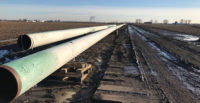It took years of debate and funding battles to move to modernize critical World War II-era uranium processing facilities at the U.S. Energy Dept.’s Y-12 complex in Oak Ridge, Tenn. considered key to America's nuclear defense.
Now, with construction completed on some parts of the multibillion-dollar project that has hard budget and schedule mandates, a Sept. 24 federal court decision could upend further work.
U.S. District Court Judge Pamela Reeves in Knoxville tossed out a 2016 plan by DOE’s National Nuclear Security Administration (NNSA)—the agency that maintains the U.S. weapons stockpile—to change its design for the Uranium Processing Facility (UPF) at the Y-12 complex, the country’s primary site for uranium operations.
Her ruling calls for added environmental and seismic risk analysis of a now $6.5-billion project, which was set in motion as early as 2004, and now must finish by the end of 2025 in time to prepare for warhead upgrading.
Nick Lawton, attorney for three plaintiffs who sought to stop construction, overseen by Bechtel National Inc., until required environmental review is completed, said it is not clear what legal authority the agency has to continue work. “It’s extremely troubling if NNSA intends to proceed,” he says.
Details of the NNSA compliance plan were published on Oct. 4 in The Federal Register.
NNSA officials acknowledged the project’s need for added seismic risk analysis claimed in a 2017 lawsuit filed by three environmental groups, but “in the meantime, construction … will proceed,” the government said in a statement.
Changing Shape
The environmental groups, which include the Natural Resources Defense Council and Oak Ridge Environmental and Peace Alliance, challenged NNSA’s 2016 revision to the facility’s 2011 construction plan for one large “big box” building to hold the entire facility. That design was scrapped when its cost was estimated at more than $19 billion.
The facility then was designed to have several smaller component structures, with parts of the original plant refurbished, using a “build to budget” strategy. NNSA announced that no further National Environmental Policy Act analysis was needed.
While originally budgeted at $650 million, added equipment and major worker safety and material security upgrades for sustained and modernized uranium manufacturing pushed up the price, NNSA said in its amended 2016 record of decision. But Judge Reeves said NNSA must conduct further NEPA review, including, at a minimum, analysis of increased earthquake risk in the region, based on a new U.S. Geological Service warning.
Reeves also said previous reviews of existing Y-12 site buildings by the Defense Nuclear Facilities Safety Board found structural and fire suppression deficiencies for their use in new nuclear weapons manufacture.
Earlier this year, in the site's original 9212 building that is still being used for uranium processing, sensors confirmed a leak and potential release of corrosive hydrogen fluoride. A site spokesman says the leak was "appropriately captured inside the equipment enclosure," with no exposure to workers or the environment. But a 1995 environmental assessment of the facility noted a 1992 leak that did affect some workers and damaged site facilities, according to a Knoxville News report that also cites the building's "history of infrastructure problems."
Reeves outlined 69 improper “categorical exclusions” by NNSA to environmental requirements. The most controversial of these is what her ruling terms an “electrorefining project” that converts impure uranium metals to a purified version using electrochemical technology “that has never been used at Y-12.” According to Reeves’ ruling, the proposed project “would require significant investment and take three years to build.”
Plaintiffs have filed a Freedom of Information Act request to have the facility budget and schedule released. “I predict the budget is more than $6.5 billion,” says Ralph Hutchinson, Oak Ridge Environmental Peace Alliance coordinator, who says $3 billion already has been spent on design.
In 2018, UPF project director John Howanitz told a local group that staying on schedule and budget “will be challenging.”
Few Details
Consolidated Nuclear Security LLC (CNS), of which Bechtel is majority partner and Leidos is a teaming partner, is Y-12 site operator and EPC construction contractor for the uranium project. CNS also operates NNSA’s Pantex federal nuclear weapons site in Texas.
NNSA declined to approve the release to ENR of any details on the scope of the project or on its cost and schedule, including project progress, as well as other design and construction information the agency received from Bechtel in response to ENR’s request.
Based on NNSA online information, media reports and other sources knowledgeable of the project, CNS will replace a set of deteriorating buildings called 9212 that were built in 1945, where enriched uranium is recycled from disassembled nuclear weapons for stockpile maintenance and to provide fuel for U.S. Navy submarines and aircraft carriers.
More than 300,000 cu yd of soil were excavated from the site and replaced with about 132,000 cu yd of concrete and 42,000 cu yd of engineered backfill to build the foundation for three new site buildings that required 210 concrete placements and nine 3-ft-deep lifts. Local media say the project is the largest ever in Tennessee.
A CNS spokeswoman said about 1,350 workers are on site, with reports predicting up to 2,200 at peak construction through 2022.
The main processing building, which will handle high-risk materials, will be 240,000 sq ft and three stories high and cost $4.7 billion. The first vertical wall was completed in May. Work continued over the summer to install the remaining 27 vertical wall sections for the building’s first floor.
The shell of a 66,000-sq-ft mechanical and electrical support building was completed this summer for an estimated $284 million. Steel columns, each 60 ft tall and weighing up to 12.5 tons, were also installed on the $1.2-billion, 127,000-sq-ft salvage and accountability building that will handle low-risk material at the site.
A 24,000-sq-ft, $140-million support facilities building will store non-nuclear materials. Two of three areas that are part of the $164-million refurbishment also are complete.
NNSA said there has been no decision by the U.S. Justice Dept. on an appeal to last month’s ruling.








Post a comment to this article
Report Abusive Comment